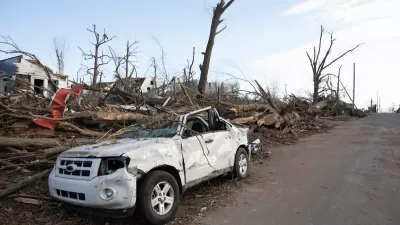Using post-Sandy New York as a case study, C.J. Hughes looks at the extent to which architects can be helpful in the immediate aftermath of a natural disaster.
Thousands of homes in the New York region were destroyed by Hurricane Sandy, but "architects eager to help rebuild have little to do, at least when it comes to anything requiring their professional skills." Even though structural damage assessments will be needed later, the priority in the weeks following Sandy have been clearing debris, delivering food, and helping people. "There is a real need for people on the ground right now, and there will be for months," said John Cary, a design consultant who co-founded the nonprofit Public Architecture and runs the site Public Interest Design. Eric Moed, a Brooklyn designer, and his group People's Relief have been delivering care packages to elderly residents in Coney Island. "I would tell any architect out there to put on some boots, grab a broom, come here, and be ready to walk upstairs," he said. "We should table the golden-ratio discussions for another three to four months."
Before the rebuilding process begins, suggests Thomas Thomas, a founder of the relief group Staten Island Strong, architects can register with the Federal Emergency Management Agency for proper identification. Relief efforts towards long-term rebuilding are being coordinated by organizations like AIA New York, which is offering safety assessments by architects, and Architecture for Humanity, which is collecting donations, offering design help, and training architects for disaster relief. "One potential hitch: Architects aren't legally allowed to perform damage assessments as volunteers," says Hughes. "New York doesn't currently have any "good Samaritan" laws to protect them against any future lawsuits, like many states do." However, Cary hopes that architects and designers will still help with the effort and said, "I would hate to think architects are sitting around because of lack of Good Sam laws."
FULL STORY: Are Architects Useful After Natural Disasters?

Maui's Vacation Rental Debate Turns Ugly
Verbal attacks, misinformation campaigns and fistfights plague a high-stakes debate to convert thousands of vacation rentals into long-term housing.

Planetizen Federal Action Tracker
A weekly monitor of how Trump’s orders and actions are impacting planners and planning in America.

In Urban Planning, AI Prompting Could be the New Design Thinking
Creativity has long been key to great urban design. What if we see AI as our new creative partner?

King County Supportive Housing Program Offers Hope for Unhoused Residents
The county is taking a ‘Housing First’ approach that prioritizes getting people into housing, then offering wraparound supportive services.

Researchers Use AI to Get Clearer Picture of US Housing
Analysts are using artificial intelligence to supercharge their research by allowing them to comb through data faster. Though these AI tools can be error prone, they save time and housing researchers are optimistic about the future.

Making Shared Micromobility More Inclusive
Cities and shared mobility system operators can do more to include people with disabilities in planning and operations, per a new report.
Urban Design for Planners 1: Software Tools
This six-course series explores essential urban design concepts using open source software and equips planners with the tools they need to participate fully in the urban design process.
Planning for Universal Design
Learn the tools for implementing Universal Design in planning regulations.
planning NEXT
Appalachian Highlands Housing Partners
Mpact (founded as Rail~Volution)
City of Camden Redevelopment Agency
City of Astoria
City of Portland
City of Laramie




























